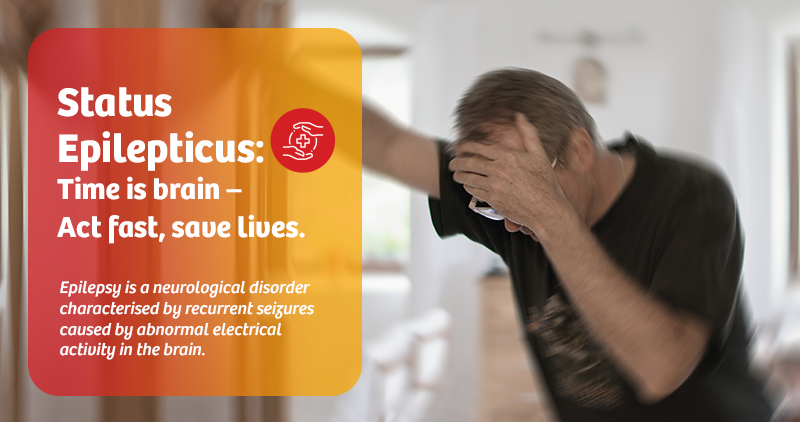Status epilepticus (SE) is a life-threatening condition characterised by a prolonged seizure or a series of seizures without recovery of consciousness between them. It is considered a medical emergency that requires immediate treatment to prevent further brain damage or even death. This blog will give insights into status epilepticus, its causes, symptoms, diagnosis, treatment, and how to manage it effectively.
What is status epilepticus?
Epilepsy is a neurological disorder characterised by recurrent seizures caused by abnormal electrical activity in the brain. Status epilepticus occurs when a seizure lasts more than 5 minutes or when multiple seizures occur without the person regaining consciousness in between. This condition can be generalised (involving the entire brain) or focal (affecting one part of the brain).
The severity of status epilepticus makes it a medical emergency because prolonged seizures can potentially lead to permanent brain injury. It's crucial to treat the condition promptly to minimise complications.
Types of status epilepticus
What comes to mind when people think of seizures?
- Convulsive status epilepticus (CSE) is the most common and most visible form of status epilepticus. It is characterised by prolonged, violent seizures that involve rhythmic jerking or shaking of the limbs, stiffening of the body, and associated loss of consciousness. These seizures typically last for more than 5 minutes or occur in rapid succession without the person regaining awareness in between.
- During a CSE episode, the body's muscles can contract and relax uncontrollably, leading to intense shaking or jerking movements. These seizures may affect the entire body, causing tonic-clonic activity (also known as grand mal seizures). Due to the force of the movements, the individual may also experience laboured breathing, incontinence, or tongue biting.
CSE is a serious medical emergency, and its prolonged nature can lead to brain injury or other life-threatening complications. Immediate medical intervention is essential to stop the seizure activity and address any underlying causes.
- Non-convulsive status epilepticus (NCSE) is a more subtle and often harder-to-recognise form of status epilepticus. Unlike Convulsive Status Epilepticus (CSE), NCSE does NOT involve vigorous shaking or jerking movements, making diagnosing it more challenging. Instead, it presents with prolonged periods of altered consciousness or changes in behaviour that may be difficult to distinguish from other medical or psychiatric conditions.
Individuals with NCSE may appear confused, dazed, or disoriented and have trouble responding to questions or commands. They may also show subtle personality changes, such as increased irritability, agitation, or even non-specific abnormal movements that are less dramatic than convulsions. Some people may appear unresponsive or detached from their surroundings, yet they may still retain some awareness. Some can have repeated hallucinations of sound, smell, or vision. It can sometimes be as subtle as just chewing movements of lips or just eye movements without any purpose.
- Despite the absence of visible convulsions, NCSE is still a serious medical emergency. If left untreated, it can lead to significant cognitive and neurological impairment. Diagnosis often requires electroencephalogram (EEG) monitoring to detect the abnormal brain activity associated with seizures, which might not be apparent through physical examination alone.
Causes of status epilepticus
The causes of status epilepticus can vary greatly and may include:
- Severe head injury or trauma
- Brain infections (e.g., meningitis, encephalitis)
- Autoimmune encephalitis (inflammation of the brain)
- Stroke or lack of oxygen to the brain
- Metabolic imbalances (e.g., low blood sugar, electrolyte disturbances)
- Severe alcohol withdrawal or intoxication
- Infection or fever (in children, especially)
- Discontinuation of epilepsy medication
- Brain tumours
- Genetic factors and certain types of epilepsy syndromes
Identifying the underlying cause of the seizure is critical for determining the appropriate treatment.
Symptoms of status epilepticus
The primary symptom of status epilepticus is a seizure that lasts longer than 5 minutes or multiple seizures that occur consecutively. Depending on the type of status epilepticus, symptoms may vary, but common signs include:
- Convulsive SE: Uncontrolled jerking movements, stiffened muscles, loss of consciousness, and inability to stop the seizure.
- Non-convulsive SE: Altered mental state, confusion, agitation, or unresponsiveness. Sometimes, it may be mistaken for a psychiatric condition.
In both cases, if left untreated, status epilepticus can lead to respiratory failure, brain injury, or even death.
Diagnosis of status epilepticus
A rapid diagnosis is essential to prevent long-term complications. Healthcare professionals often use the following methods to diagnose status epilepticus:
- Video electroencephalogram (VEEG): At KD Hospital, we measure electrical activity and video record brain activities. VEEG is key in confirming the presence of ongoing seizures and can help differentiate between convulsive and non-convulsive status epilepticus.
- Blood tests help detect metabolic imbalances, infections, or drug levels.
- Imaging (CT or MRI): These scans can identify brain injuries, strokes, or tumours that may trigger seizures.
Treatment of status epilepticus
The treatment of status epilepticus aims to stop the seizures as quickly as possible to prevent brain damage. It usually involves the following steps:
- Initial treatment (First-Line):
- Benzodiazepines such as lorazepam or diazepam are commonly administered intravenously or rectally to stop the seizures quickly.
- Oxygen therapy ensures that the brain gets enough oxygen during the seizure.
- Second-line treatment: If seizures continue after benzodiazepines, other anticonvulsants like phenytoin, valproate, or levetiracetam may be used.
- Refractory status epilepticus (RSE): In cases where seizures do not stop with standard treatments, more aggressive approaches such as general anaesthesia (using intravenous medications like propofol or barbiturates) may be needed to induce a controlled coma, allowing the brain to rest.
- Treating the underlying cause: If an identifiable cause, such as a brain injury, stroke, or infection, treating this cause is critical to prevent further seizures.
Prognosis and outcomes
The outcome of status epilepticus largely depends on the underlying cause and how quickly treatment is administered. If seizures are stopped early, the chances of a full recovery are much higher. However, if treatment is delayed, there is a risk of permanent brain damage and death.
Complications of long-lasting seizures can include:
- Cognitive impairments
- Physical disabilities
- Psychological effects such as depression or anxiety
For people who experience status epilepticus, continued medical monitoring and sometimes long-term treatment may be required to prevent recurrence.
Preventing status epilepticus
While some causes of status epilepticus, such as strokes or brain injuries, may be unavoidable, individuals with epilepsy can take several proactive steps to minimise their risk:
- Adhering to prescribed medications and not missing doses.
- Regular follow-up appointments with a healthcare provider.
- Identifying and avoiding known seizure triggers, such as lack of sleep, stress, and flashing lights (for photosensitive epilepsy).
- Seeking medical attention if an individual experiences a sudden seizure frequency or severity worsening.
In a nutshell:
Status epilepticus is a medical emergency that demands immediate attention. Prompt treatment can prevent long-term complications, but delaying care can result in irreversible damage. At KD Hospital, we have Gujarat’s comprehensive epilepsy care center with two epileptologists (Epilepsy Specialist Neurologists) and a Neurosurgical team under one roof who work to treat focal epilepsy with a rational and scientific approach. Our focus is to give specific disease-based treatment with medical and surgical interventions.

